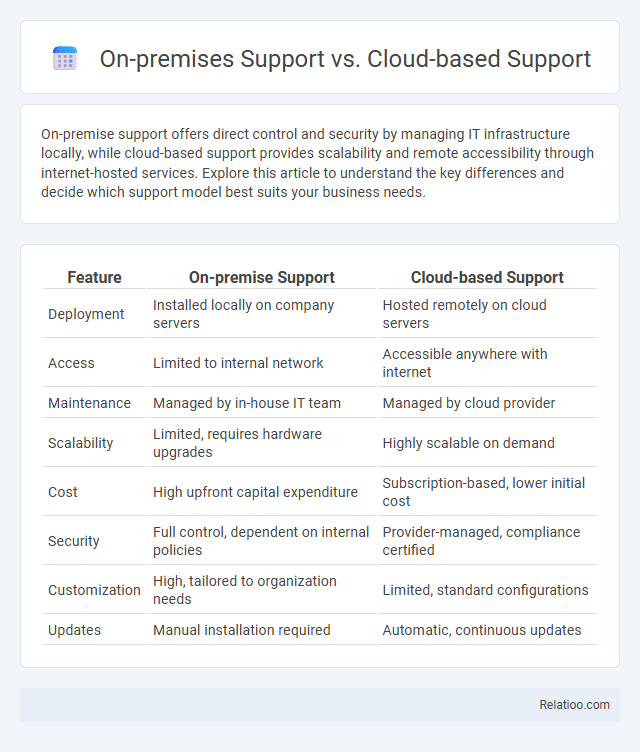On-premise support offers direct control and security by managing IT infrastructure locally, while cloud-based support provides scalability and remote accessibility through internet-hosted services. Explore this article to understand the key differences and decide which support model best suits your business needs.
Table of Comparison
| Feature | On-premise Support | Cloud-based Support |
|---|---|---|
| Deployment | Installed locally on company servers | Hosted remotely on cloud servers |
| Access | Limited to internal network | Accessible anywhere with internet |
| Maintenance | Managed by in-house IT team | Managed by cloud provider |
| Scalability | Limited, requires hardware upgrades | Highly scalable on demand |
| Cost | High upfront capital expenditure | Subscription-based, lower initial cost |
| Security | Full control, dependent on internal policies | Provider-managed, compliance certified |
| Customization | High, tailored to organization needs | Limited, standard configurations |
| Updates | Manual installation required | Automatic, continuous updates |
Introduction to On-premise and Cloud-based Support
On-premise support involves managing software and hardware resources directly within your organization's infrastructure, providing full control over data security and system customization. Cloud-based support leverages remote servers hosted on the internet, offering scalable resources, reduced maintenance costs, and easy accessibility from anywhere. Understanding these core differences helps you choose the best support model aligned with your business needs and IT strategy.
Key Differences Between On-premise and Cloud-based Support
On-premise support involves managing IT infrastructure within a company's physical location, providing full control and customization but requiring significant upfront investment and ongoing maintenance. Cloud-based support offers scalable, remote access to IT services via the internet, reducing capital expenses and enabling faster deployment but relying on third-party providers for security and uptime. Key differences include control level, cost structure, scalability, deployment speed, and responsibility for system updates and security management.
Cost Comparison: On-premise vs Cloud-based Support
On-premise support typically involves higher upfront costs due to hardware acquisition, software licenses, and infrastructure maintenance, whereas cloud-based support operates on a subscription model with predictable ongoing fees. Your total cost of ownership (TCO) for on-premise solutions can increase with additional IT staff and energy consumption, while cloud services often reduce these expenses by leveraging shared, scalable resources. Evaluating long-term financial impact requires analyzing deployment scale, customization needs, and potential savings on physical infrastructure through cloud adoption.
Security Considerations in Support Solutions
On-premise support offers enhanced control over security protocols by housing data within an organization's local infrastructure, minimizing exposure to external threats but requiring significant in-house expertise and resources to manage. Cloud-based support provides scalable security features managed by providers, including advanced encryption and continuous monitoring, yet introduces risks related to data sovereignty and potential breaches in multi-tenant environments. Resource allocation must prioritize robust cybersecurity measures tailored to the chosen support model, balancing compliance requirements, incident response capabilities, and cost-efficiency to maintain comprehensive protection across support operations.
Scalability and Flexibility: Which Is Better?
On-premise support provides limited scalability as it relies on fixed hardware and infrastructure, whereas cloud-based support offers dynamic scalability with on-demand resource allocation and elastic computing power. Cloud solutions enable greater flexibility by allowing businesses to quickly adjust resources to match fluctuating workloads, while on-premise systems require time-consuming manual upgrades. Resource allocation in cloud environments optimizes costs and operational efficiency, making it a superior choice for scalability and flexibility compared to traditional on-premise support.
Performance and Reliability Analysis
On-premise support ensures higher control over hardware performance and data security, delivering consistent reliability tailored to your infrastructure needs. Cloud-based support offers scalable resources with robust redundancy, minimizing downtime through distributed systems and real-time updates. Choosing between these options depends on your performance requirements, where on-premise excels in low-latency tasks and cloud-based support provides superior flexibility and disaster recovery capabilities.
Customization Capabilities for Businesses
On-premise support offers extensive customization capabilities by allowing businesses to tailor software and infrastructure to specific operational needs, ensuring full control over security and integration. Cloud-based support provides scalable customization options through configurable platforms and APIs, enabling rapid deployment and flexibility without the overhead of physical hardware management. Resource allocation in on-premise setups demands upfront investments in IT personnel and hardware, whereas cloud-based models optimize resource efficiency via subscription-based services and automatic updates, facilitating agile business adaptation.
Compliance and Regulatory Implications
On-premise support ensures full control over data security and compliance with strict regulatory requirements, making it ideal for industries with stringent data governance laws. Cloud-based support offers scalability and flexibility but may pose challenges in meeting specific regional compliance standards due to data residency and shared infrastructure. You should evaluate your organization's regulatory obligations and risk tolerance when choosing between these support models to maintain compliance and protect sensitive information.
Ease of Deployment and Maintenance
On-premise support requires significant time and expertise for deployment and ongoing maintenance due to hardware setup and software updates managed internally. Cloud-based support offers streamlined deployment with minimal upfront infrastructure, enabling automatic updates and simplified maintenance handled by the service provider. Resource allocation in cloud environments adjusts dynamically, reducing the operational burden compared to the fixed resource demands of on-premise systems.
Choosing the Right Support Solution for Your Organization
Selecting the right support solution depends on an organization's specific needs, budget, and infrastructure. On-premise support offers greater control and security for sensitive data but requires higher upfront investment and ongoing maintenance. Cloud-based support provides scalability, flexibility, and reduced IT overhead, while resource allocation must align with the organization's growth projections and operational priorities to ensure optimal efficiency and cost-effectiveness.

Infographic: On-premise Support vs Cloud-based Support
 relatioo.com
relatioo.com